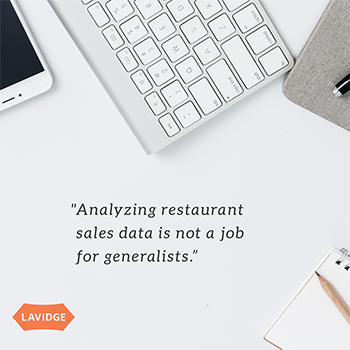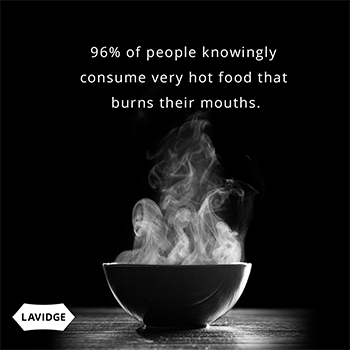Need fresh thinking? Help is a few keystrokes away.
Organize and Analyze
If you own or operate restaurants, you already have a secret weapon that can unlock a treasure trove of information that will help increase revenue: your customers.
Every time someone orders a meal, they also provide a wealth of extremely useful sales data that can be analyzed and converted into more revenue. Your point of sale (POS) system is likely already primed to deliver important insights to help tweak your menu, staffing and marketing strategies. But analyzing customer data can be tricky.
Here’s where to start when you’re ready to take a deep dive into your sales data.
Don’t DIY
This may be the biggest mistake when it comes to analyzing restaurant sales data. It’s tempting for any restaurant owner to scrutinize their own numbers. After all, no one understands your restaurant business like you. And you may be reticent to permit an outsider to view your highly sensitive finances. Your intimate knowledge of your restaurant’s P&L will enable you to quickly parse sales information into actionable intelligence, right?
 Not necessarily. Analyzing restaurant sales data is not a job for generalists. You go to a board-certified physician when you’re sick. And you only trust your car to skilled mechanics. Your business is your livelihood, so lean on restaurant analytics experts who have a proven track record of analyzing restaurant sales data.
Not necessarily. Analyzing restaurant sales data is not a job for generalists. You go to a board-certified physician when you’re sick. And you only trust your car to skilled mechanics. Your business is your livelihood, so lean on restaurant analytics experts who have a proven track record of analyzing restaurant sales data.
The cliché about not seeing the forest for the trees is true here. An outside party can provide an unbiased report, and can bring knowledge about the local economy and seasonal information that will help create measurable recommendations for effective restaurant marketing.
Also, when you rely on experts to help analyze your sales data, give them complete access to everything. Don’t hold back. Unless your restaurant analytics agency has a complete picture of your business—including all sales and promotion outcomes—their recommendations for marketing your restaurant will be based on incomplete information and, as a result, may be faulty.
Focus on the few
Too much analysis can be paralyzing. That’s why you’d be smart to focus on your core menu items and a select few restaurant industry KPIs (key performance indicators). Is it critical to dissect sales data related to side orders of baked potatoes? Probably not. Work closely with your sales data analyst to choose the most important menu items to watch.
The National Restaurant Association suggests that guest-check analytics can help uncover valuable information from “total sales, total covers, average check, food and beverage costs, labor costs by department, sales and covers by server, and the cost of voids and promotions.”
KPIs worth following include gross margin per product sold, gross profit, data and ratios related to cash flow, and costs of goods sold (COGS). Your agency and/or analysist will assist with creating views into this data by promotion and overall menu.
Be patient
 We live in a society that emphasizes instant gratification. We’re so impatient that, according to a survey by Fifth Third Bancorp, “96% of Americans knowingly consume extremely hot food or drink that burns their mouths, and 63% do so frequently.”
We live in a society that emphasizes instant gratification. We’re so impatient that, according to a survey by Fifth Third Bancorp, “96% of Americans knowingly consume extremely hot food or drink that burns their mouths, and 63% do so frequently.”
Patience is definitely a virtue when it comes to analyzing sales data. There’s little value in scrutinizing overnight sales receipts. A meaningful analysis utilizes data covering several weeks of sales. In most cases, a quarterly study should be sufficient, followed by an in-depth annual review.
Look for cause and effect
Finally, be sure that any financial examination pays particular attention to traffic and sales generated from marketing activities, including advertising, coupons and special promotions.
Need help?
Not sure where to start? LAVIDGE has extensive experience analyzing restaurant sales data to develop killer restaurant marketing strategies. We'd love to create one for you.
To learn more, give us a call at 480.998.2600 or send email to [email protected].
Restaurant Data Fundamentals
The National Restaurant Association offers the following data checklist to help restaurants prepare for an effective sales analysis.
-
Talk to your POS vendor. Find out whether you’re getting all the information readily available from the data you collect.
-
Take the time to carefully categorize food and beverage items in your POS system.
-
Evaluate what your payments processor may have to offer. You may be surprised at the amount of data it has about your guests.
-
Find out whether all your systems talk to each other. Your restaurant is a complete ecosystem of software and networks.
-
Avoid drowning in too much data. Rob Bailey, CEO of Datasift, says, “Enterprises need to define a focused strategy and identify exactly the data they need, rather than trying to analyze everything.”
-
Determine your goals. Identify the type of data you need.
Updated April 4, 2019
2017 Southwest Food Service Marketing Report

This article is a brief abstract of our exclusive and authoritative study that takes the guesswork out of food service advertising and marketing. Rather than speculating about what will drive consumers to action, we've asked them.


